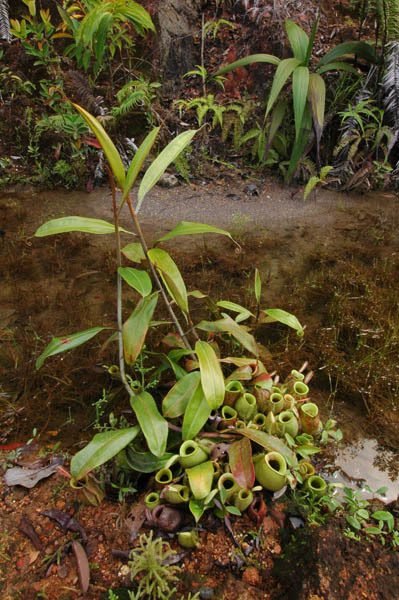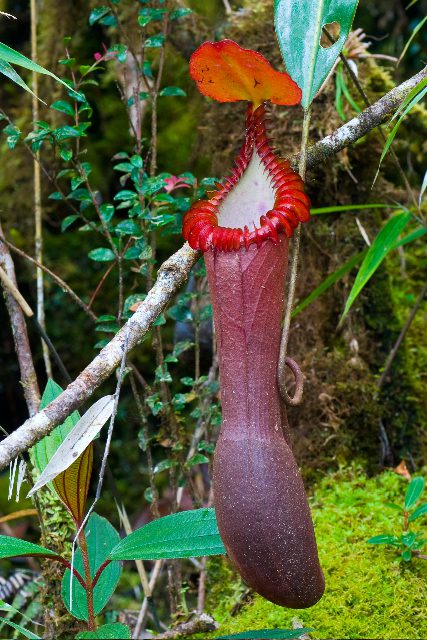Tropical pitcher plant belong to The genus Nepenthes which belongs to the monotypic family , consists of 130 species and does not include natural or artificial hybrids. This genus is a carnivorous plant in the tropics of the Old World , now including Indonesia , southern China , Indochina , Malaysia , Philippines , western Madagascar , Seychelles , New Caledonia , India. , Sri Lanka , and Australia . The habitat with the most species is on the islands of Borneo and Sumatra .
| Scientific classification | |
|---|---|
| Kingdom: |
Plantae
|
| Division: |
Magnoliophyta
|
| Class: |
Magnoliopsida
|
| Order: |
Caryophyllales
|
| Family: |
Nepenthaceae
Dumort. (1829)
|
| Genus: |
Nepenthes
L. (1753)
|
Physical characteristics
This Tropical pitcher plant can reach a height of 15-20 m by climbing other plants, although there are some species that do not climb. At the tips of the leaves there are tendrils that can be modified to form pockets, which are traps used to eat their prey (eg insects , pacets , frogs ) that enter inside. [1] These bags are used to meet nutritional needs that are not available in growing habitats. [2]

In general, Nepenthes has three types of pouches, namely upper pouch, lower pouch, and rosette pouch. The upper bag is a pouch from an adult plant, usually funnel-shaped or cylindrical, has no wings, does not have an attractive color, the tendrils are facing backwards and can be wrapped around the branches of other plants, the upper bag more often catches flying animals such as mosquitoes or flies, pouches this species is rare or not found in some species, for example N. ampullaria. The lower pouch is a pouch produced on the part of a young plant which is usually lying on the ground, has two wings that serve as a tool for soil insects such as ants to climb up the mouth of the bag and finally plunges into the enzymatic liquid inside, while the rosette pouch has a similar shape. the same as the lower pouch, but the rosette pouch grows on the rosette-shaped leaf, examples of species that have this type of pouch are N. ampullaria and N. gracilis . Some plants sometimes secrete a central pouch that is shaped like a mixture of a lower bag and an upper bag.
Taxonomy
About 160 species of Nepenthes are officially recognized at this time, which is a rapidly increasing number, with several new species being defined each year. [3]
Habitat
This Tropical pitcher plant has a very wide distribution from the coast to the highlands, because of this Nepenthes is divided into two types, namely the highland type and the lowland type, although most species grow in the highlands. The species recorded growing at the highest altitude was N. lamii at an altitude of 3,520 m. [1] [4]
Most species grow in places with high humidity and moderate to high levels of light. Some species such as N. ampullaria grow in shady places with not too much light, while N. mirabilis grows in open areas with abundant light. The soil in which nepenthes grows is usually poor in nutrients and acidic. Some species grow in places that are highly toxic to other plants such as N. rajah which grows on soils containing heavy metals and N. albomarginata which grows on sandy beaches in zones exposed to sea water, some species grow epiphytes such as N. inermis which grows without touching the ground. [1]
This plant grows in marginal soils poor in nutrients, especially nitrogen (such as peat soil, heath, lime soil, swamp). [5]
Symbiosis with bats
Woolly bats (genus Kerivoula ) are known to have symbiosis with pitcher plants. The bat sleeps in it while protecting itself from insects that will slip into the pitcher bag. In addition, bat droppings are also nutritious for semar bags. [6]
References
- Barthlott, W., Porembski, S., Seine, R., and Theisen, I. 2007.The Curious World of Carnivorous Plants. Portland, Oregon: Timber Press.
- Muhammad Mansur. Potensi Serapan CO2 Pada Beberapa Jenis Kantong Semar Dataran Rendah. Berita Biologi. Volume 16 No. 1, April 2017
- Clarke, CM & CC Lee 2004. Pitcher Plants of Sarawak . Natural History Publications (Borneo), Kota Kinabalu.
- Jebb, M.; Cheek, M. (1997). ” A skeletal revision of Nepenthes (Nepenthaceae) “. Blumea . 42 : 1–106.
- Muhammad Mansur. Potensi Serapan CO2 Pada Beberapa Jenis Kantong Semar Dataran Rendah. Berita Biologi. Volume 16 No. 1, April 2017
- Fuchs, Hannah (2013). Legowo, Vidi, ed. “The Unique Symbiosis of the Bornean Bat” . DW.DE (in English) . Retrieved 22 September 2013 .

